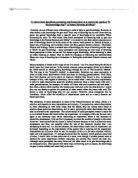Importance and limitations of sense perception
- It is often claimed that information and communication technologies are blurring the traditional distinctions between simulation and reality. If this is so, what might be the consequences?
TV programs and others information and communication technologies in which there are illusionists, super heroes or violent cartoons, often convince children that these show the real life ,and as consequence, children copy them trying to fly from a high floor like Superman or to use Kung Fu fighting like Dragonball or other violent videogames. Children in fact are in a learning and growing phase because they are “TABULA RASA”, that is children don’t have culture and experience, that doesn’t permit them to distinguish realty from imagination and they absorb everything that seems real.
One example of these technologies of communication is the subliminal messages that are information that our brain learns unconscious. They are a pervert mechanism through which we become aware of fixed information, and visual and audio, but we also become aware another one.
The subliminal messages can be found in a simple advertising poster, in the TV programs or in the music or dialogues.
For example in the Disney films such as Aladdin, Bianca and Bernie and the Lion King, sometimes appear messages about adult contents and other trademarks. Watching these movies, as consequence, children have a very violation of the conscience making unaccountable changes of the behavior. Music is another way to spread subliminal messages. Sometimes if these songs are listened on inside out, we can find these (an example is the song “Better” of “You Better than me making Judas Priest to be guilty as they convinced two teenagers to suicide with the lyrics “Do it, Do it”. In conclusion subliminal messages manipulate people through their senses convincing them to buy more and more a kind of product.
Linking questions
- What can be meant by the Panchatantra saying “Knowledge is the true organ of sight, not the eyes”? Is it necessary to have clear ideas to see?
“Knowledge is a true organ of sight, not the eyes" is a quite interesting quote by Panchatantra. The sight is one of senses through which we receive information from outside. These information must be worked out .It exchanges from active perception to passive perception. But this isn’t enough: it is necessary to have clear ideas to see.
If we don’t have clear ideas, sight often can cheat us: for example, in classroom we have seen videos or pictures about illusions pictures in which I saw an elephant with 4,6 or 12 legs, and a saxophonist that seemed also a beautiful woman’s face. But I know that an elephant has 4 legs and the saxophonist is a man!
This is because I have clear ideas about elephants.
A blind can’t see with eyes but he can see through the other senses. He can read through touch and Brail writing and also play the piano with audio memory.
Another example, that could be ”rash”, is about desert mirages which are optical phenomena created by light’s refraction which makes things seeming moved laterally or above horizon. If you don’t have clear ideas to see, you can follow these mirages thinking they are true and die.
Sense perception and areas of knowledge
- What role does what we expect to see, or are used to seeing, play in what we observe? For example, after learning about the structure of cells from a textbook, how “neutral” might the observation of a slide under microscope be? Can we learn how to see things properly?
We perceive the world through our five senses: sense perception is the active, selective and interpretative process of recording or becoming conscious of the external world because sensory perception is an important dimension of our understanding of the world.
Galileo Galilei, one of the greatest scientists of the history, based “Experimental Method” upon the observation and upon artificially production of natural Phenomena. That observation has become one important part of Chemistry, Physics, and Biology and it has permitted to reach the actual knowledge grade of nature. The observation of phenomenon is the first step of the method that begins with the focus of the problem that we want to study and it’s necessary not to have a preconception (that means to have an idea formed without true opinions or direct experience). For example, in a chemistry experiment, I had put an Mg ribbon into the Bunsen flame and I’ve seen that it glowed with a white shiny light and I’ve balanced seeing that its mass was changed. How was that? There had been a transfer of electrons from the Oxigen to the Mg Ribbon. Of course you cannot see this passage of electrons, but the study of the theory told me exactly what was going to happen. Thus, observation itself cannot be enough to reach knowledge but we need to verify and test what we observe. Anyway, great discoveries of science sometimes, come from great intuitions with no need of pre-formed concepts. In the end we can state that a good mix of observation and study makes the path of human knowledge more reachable.







